Our question for Unit 2 of Star Trek: Inspiring Culture and Technology is this:
To what extent did the business model of network television enable Star Trek: The Original Series to appeal to such a wide range of audiences? In ways did that same model constrain it?
According to the Unit 2 course materials, and reinforced in books like Inside Star Trek by Robert Justman and Herb Solow and These Are The Voyages by Marc Cushman, Star Trek worked for the business model of network television because it promised to be a family-friendly show about space exploration at a time when the American public was fascinated with the Space Race and technological advances. With limited programming options, networks wanted shows that would convince the whole family to sit down and watch together and not stand up to change the channel. Roddenberry’s “wagon train to the stars” pitch seemed to fit that bill.
However, Star Trek was ahead of its time in more ways than one and with its vision came budgets for special effects and sets that were well out-of-step with its contemporaries like My Three Sons and Gomer Pyle. And the way we measured TV ratings didn’t take into account demographics the way we do today. Trek was attracting a loyal following of younger fans, but the ratings appeared worse than they were, which did not help justifying the costs of production.

Even Lucille Ball, who was a loyal champion of the show, couldn’t save it after she sold Desilu to Paramount. When the show was slotted at 10 pm on Fridays for the third season, everyone knew it was the end. Teenagers would go out on Friday nights and not be home to persuade the rest of their family to turn on Star Trek. Younger kids would be in bed already.
There were two aspects of the business model of network TV that weren’t mentioned in the course materials. One is that Star Trek was airing just as TV manufacturers like RCA were really convincing people to try colour television. Star Trek proved to be especially persuasive in convincing people to switch. It was attractive in black and white but you were really missing something if you weren’t watching in colour.

Another important part of the business model of network television was syndication. If you wanted your show to run in syndication you needed a certain number of episodes, which Star Trek‘s creators and fans knew during their all-important letter writing campaigns. By convincing Paramount to produce an entire third season they would have just enough episodes to run in syndication.
In the end, the fans and the creators didn’t save Star Trek: The Original Series, but they did save the franchise. With TOS running in syndication it would end up garnering a whole new generation of rabid fans, positioning it well for the era of cable TV.












1 Comment
Add Yours →Love the Lucille Ball pic! Also enjoyed reading a woman’s point of view. It is interesting and a bit unknown that a woman was so influential and the main supporter Star Trek.